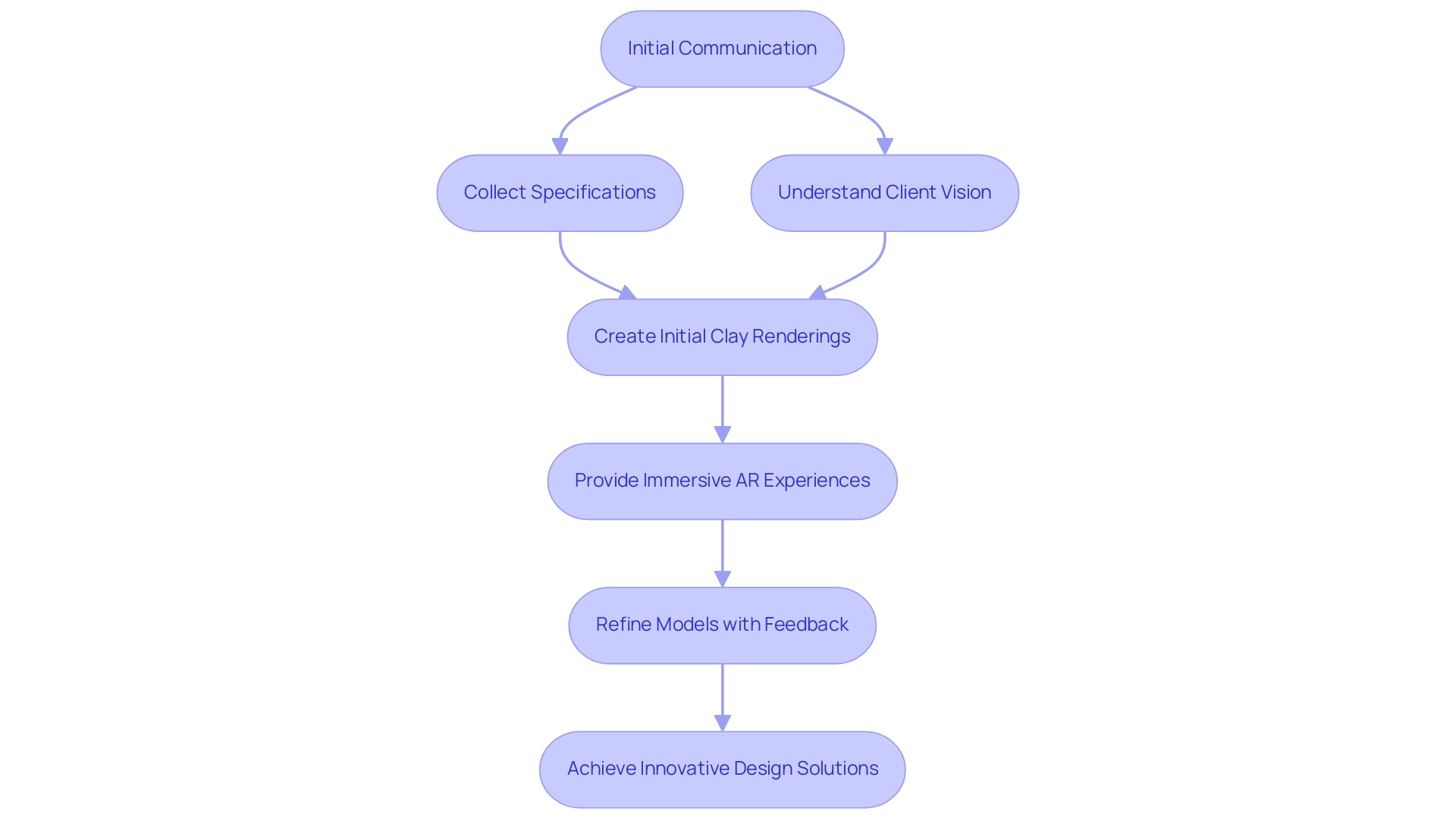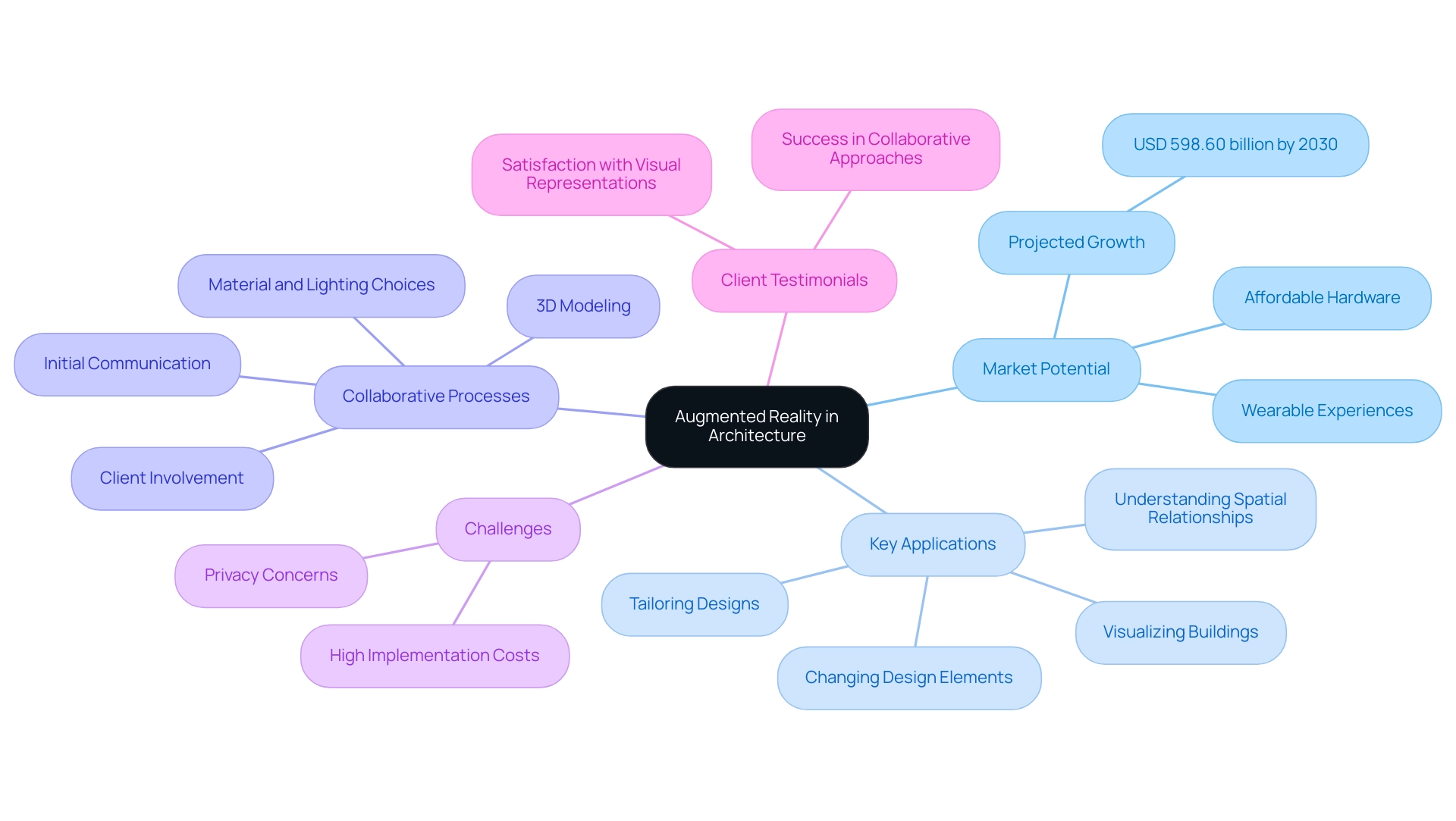Overview
The article highlights ten inspiring examples of how augmented reality (AR) is being utilized in architectural projects to enhance design visualization and stakeholder engagement. By showcasing various case studies, such as the AR City Project and initiatives by Zaha Hadid Architects, the article illustrates how AR facilitates real-time visualization of designs within physical spaces, ultimately improving communication, understanding of spatial relationships, and fostering innovative design solutions.
Introduction
In the dynamic landscape of architectural design, the integration of Augmented Reality (AR) is not merely an enhancement; it represents a paradigm shift that redefines how architects conceptualize and communicate their visions. By enabling real-time visualization of projects within their actual environments, AR facilitates a more profound engagement with clients and stakeholders, fostering collaborative dialogues that transcend traditional design processes.
As this technology evolves, its applications extend beyond mere visualization, influencing urban planning, educational methodologies, and sustainable practices. This article delves into the transformative impact of AR on architectural innovation, exploring inspiring case studies, the integration of AR in education, and the challenges that firms face in adopting these cutting-edge tools.
Through a comprehensive examination of these elements, the potential for AR to revolutionize the architectural landscape becomes increasingly apparent, positioning it as an indispensable asset for future-ready architects.
Transforming Architectural Design Through Augmented Reality
Augmented Reality (AR) is transforming architectural design, showcasing examples of exploring augmented reality in architectural projects by enabling architects to visualize plans in real-time within their actual environments. This innovative technology facilitates the seamless integration of virtual elements into physical spaces, which serves as examples of exploring augmented reality in architectural projects, thereby enhancing communication with clients and stakeholders. At J. Scott Smith Visual Designs, our joint visualization process starts with initial communication, where we collect specifications and comprehend client vision.
This includes the creation of initial clay renderings that provide a tangible starting point for discussions. By providing immersive experiences, AR significantly enhances the creation process, which includes examples of exploring augmented reality in architectural projects, enabling detailed 3D models that represent the intent of the work. We meticulously select materials and lighting to ensure that every aspect of the undertaking aligns with client expectations, and we refine our models based on ongoing feedback.
The ability to visualize scale, materials, and lighting in situ, highlighted by examples of exploring augmented reality in architectural projects, not only enhances design accuracy but also cultivates a profound understanding of spatial relationships, fostering deeper connections between the project and its future residents. This results in more innovative design solutions that are both functional and aesthetically pleasing. Furthermore, as the consumer AR advertising market is projected to reach $5.2 billion by 2024, it’s evident that the construction industry is poised to benefit from examples of exploring augmented reality in architectural projects and the growing emphasis on AR technologies.
Notably, a study found that 67% of media agency executives advocate for increased AR/VR advertisement use, indicating a strong desire for interactivity that can effectively engage consumers and counteract ad-blocking trends. As IDC noted, $190 million is expected to be spent in other segments, highlighting the broader investment in AR technologies. Additionally, as the demand for sustainable building materials is expected to grow by 6.7% annually through 2027, there are numerous examples of exploring augmented reality in architectural projects that not only support enhanced visualization but also align with contemporary sustainability goals.
Inspiring Case Studies: Augmented Reality in Action
The AR City Project: This groundbreaking initiative leverages augmented reality (AR) to superimpose digital information onto urban landscapes, empowering city planners to visualize prospective developments in real-time. A notable case study is an example of exploring augmented reality in architectural projects, specifically the permit process in Vienna, where AR is utilized to visualize planned developments in relation to their surroundings, aiding in architectural assessments during the expert opinion preparation. By incorporating high-quality visual renderings and interactive displays, the initiative fosters public engagement, allowing stakeholders to grasp proposed changes more comprehensively. This approach enhances transparency and facilitates community involvement in the planning process, underscoring the essential role of visualization in development. Vienna’s building management department oversees 1613 buildings, illustrating the scale at which AR can influence urban planning. For further insights, you can explore our portfolio that showcases similar successful projects and read our blog for industry updates and expert articles.
Zaha Hadid Architects’ AR Initiatives: As a leader in innovative design, Zaha Hadid Architects have adeptly integrated AR into their presentations, revolutionizing the way concepts are conveyed to clients. The firm’s commitment to pushing the boundaries of design presentation reflects a growing trend in the industry, where client interaction and engagement are paramount. The use of high-quality renderings in conjunction with AR is not merely a ‘nice to have’ but provides examples of exploring augmented reality in architectural projects, transforming stakeholder engagement and understanding, and thereby generating investment and confidence in projects. Our portfolio features examples of similar initiatives that highlight these advancements.
The Museum of the Future: Situated in Dubai, this design marvel exemplifies the fusion of AR with visitor experiences. By utilizing augmented reality applications, guests can interact with various exhibits, gaining profound insights into the building’s aesthetic and functional design. This innovative approach not only enhances the visitor journey through high-quality visualizations but also integrates storytelling into the experience, offering examples of exploring augmented reality in architectural projects and demonstrating how AR can transform the way architecture is perceived and appreciated. This case emphasizes the impact of project complexity and scale on rendering time and resource requirements, showcasing the essential role of visualization in the design process. For more detailed examples of our visualization services and their effectiveness, please visit our portfolio and blog.
Augmented Reality in Architectural Education: Shaping Future Designers
The integration of Augmented Reality (AR) into design education is fundamentally reshaping the learning landscape for aspiring architects. Educational institutions are increasingly adopting AR tools within their curricula, allowing students to engage with virtual models and simulations in a dynamic manner. This experiential learning method significantly improves students’ understanding of spatial dynamics and principles.
For example, programs that utilize AR technology serve as examples of exploring augmented reality in architectural projects, allowing students to visualize their designs in real-world contexts, fostering creativity and cultivating critical thinking skills essential for contemporary design practice. Moreover, the investment in top-notch visual representations plays a crucial part in development and decision-making, acting as a glimpse into the future of construction endeavors. These representations not only enable stakeholders to perceive the potential and grasp the vision behind plans but also generate enthusiasm about forthcoming endeavors by vividly depicting what is ahead.
This excitement is crucial for garnering support and enthusiasm from clients and team members alike. As the global digital asset management market is projected to reach $16.18 billion by 2032, growing at a CAGR of 17.0%, it is evident that technological advancements are influencing educational methodologies and the design field. Additionally, with 175 accredited architecture programs across 139 institutions in the U.S., primarily focused on master’s degrees, there is a clear trend toward incorporating AR tools into these programs.
By equipping students with these innovative tools, institutions ensure that the next generation of architects is adept at harnessing technology and high-quality visualizations to elevate their professional practices. The synergy between AR tools and high-quality renderings enhances both the learning experience and the effectiveness of architectural presentations, ultimately leading to more informed decision-making and successful project outcomes.
The Future of Augmented Reality in Architectural Innovation
The future of augmented reality (AR) in architecture is set to be transformative, driven by significant advancements in AR technology and mobile applications. As the AR market is anticipated to attain an impressive USD 598.60 billion by 2030, architects will benefit from enhanced hardware capabilities that enable efficient site analysis and assessment evaluations. Gennadiy Vaksman, Director of Engineering at TELUS Agriculture & Consumer Goods, highlights this evolution:
I’m amazed by how augmented reality is transforming as-built verification!
This technology streamlines the process and ensures greater accuracy. Exciting times ahead! As AR becomes more widely available, its incorporation into collaborative processes will improve teamwork and communication across disciplines.
Key applications of exploring augmented reality in architectural projects include:
- Visualizing buildings or rooms
- Understanding spatial relationships
- Changing design elements
- Tailoring designs to client preferences
The cooperative visualization process at J. Scott Smith Visual Designs illustrates this method, highlighting the significance of:
- Initial communication
- Thorough 3D modeling
- Material and lighting choices
- Client involvement to meet specifications
Throughout the creation process, refinement is crucial to ensuring the final product meets client expectations.
Moreover, the use of AI in creating lifelike CG humans is bridging the uncanny valley, allowing for more realistic visualizations that greatly impact project development and decision-making. However, addressing current challenges in the AR market, such as high implementation costs and privacy concerns, is crucial. The case study titled ‘Challenges and Opportunities in Augmented Reality’ illustrates that while challenges exist, they also present opportunities for growth in various sectors, including examples of exploring augmented reality in architectural projects.
As these technologies continue to advance, architects must remain adaptable, embracing AR as an integral component of their workflows. Testimonials from clients highlight the effectiveness of this collaborative approach, showcasing the satisfaction and success achieved through high-quality visual representations.
Challenges and Considerations in Implementing Augmented Reality
While augmented reality (AR) offers transformative opportunities for design presentations, its implementation is fraught with challenges, particularly for smaller firms. A primary obstacle is the substantial cost of AR technology and associated software, which can deter many smaller practices from adopting these innovative tools. In fact, the cost analysis indicates that the initial investment required for high-quality AR systems can be prohibitive.
Alongside this financial hurdle is a considerable learning curve; architects and their teams must allocate time and resources for thorough training to effectively employ these new technologies.
Conversely, investing in high-quality visuals can serve as a glimpse into the future of your architectural projects, offering clarity that is essential for informed decision-making and generating enthusiasm about what lies ahead. Collaborating with J. Scott Smith Visual Designs enables companies to visualize and confirm their concepts through initial images, improving the cooperative creation phase with ongoing feedback. This investment not only aids in decision-making but also fosters enthusiasm among stakeholders.
Furthermore, successful AR integration demands high-quality hardware and dependable internet connectivity, presenting additional technical hurdles that smaller firms may struggle to overcome.
As noted by industry experts, the technical limitations must be navigated carefully to ensure that AR experiences are seamless and effective. In the context of a competitive architecture industry, where there are 175 accredited programs across 139 institutions in the U.S. (NAAB), smaller firms face increased pressure to adopt advanced technologies to remain relevant.
The global digital asset management market is projected to reach $16.18 billion by 2032, growing at a CAGR of 17.0%, highlighting the growing importance of digital tools like AR and high-quality visualizations in architecture. Moreover, the examples of exploring augmented reality in architectural projects serve as a powerful marketing tool that allows clients to explore virtual models in detail, enhancing client attraction and improving the visualization of the final product. However, addressing the multifaceted challenges of privacy and data security, especially when AR applications handle sensitive client information, is essential for architects aiming to leverage AR technology effectively, ensuring they can harness its potential in an increasingly competitive marketplace.
Ready to explore the potential of your architectural ideas? Partner with J. Scott Smith Visual Designs to visualize and validate your ideas with our preliminary renderings. Contact us today to schedule a consultation and see how we can help bring your design concepts to life.
Conclusion
The integration of Augmented Reality (AR) into architectural practice is revolutionizing design processes by enhancing communication and real-time visualization among architects, clients, and stakeholders. Case studies such as the AR City Project in Vienna and the Museum of the Future demonstrate how AR fosters deeper engagement and understanding of architectural concepts.
In educational settings, AR is transforming how future architects learn, allowing them to visualize designs in real-world contexts and develop essential skills such as creativity and critical thinking. As the demand for AR technologies increases, it is crucial for architectural education to incorporate these tools to prepare students for a technology-driven industry.
While challenges such as high costs and technical limitations persist, particularly for smaller firms, the benefits of improved design accuracy and enhanced stakeholder engagement underscore the importance of overcoming these hurdles.
Ultimately, the future of architectural design hinges on the successful integration of AR. By embracing this technology, architects can unlock innovative solutions and maintain a competitive edge in an evolving landscape. The time to adopt AR as a core component of architectural practice is now, as it stands poised to redefine industry possibilities for years to come.






0 Comments